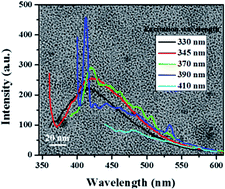The sonochemical synthesis of Ga@C-dots particles
Abstract
This research article is focused on a one-step sonochemical fabrication of carbon dots (C-dots) doped with Ga atom (Ga@C-dots). The synthesis is carried out by sonicating in molten Ga, polyethylene glycol (PEG-400) as the reaction medium for 30–120 min. The produced Ga@C-dots is present in the PEG supernatant and has an average diameter of 5 ± 2 nm. Herein, fluorescence is used to probe the emission of Ga@C-dots and to examine if it differs from that of pristine C-dots. The new product was also characterized by fluorimetric, surface charge potential, and XPS (X-ray photoelectron spectroscopy) measurements. It was revealed that the physical properties of the Ga@C-dots are different from pristine C-dots. We attribute the fluorescence spectrum to energy transfer from the C-dots to the Ga particles. Ga@C-dots show high photosensitization with respect to pristine C-dots.


 Please wait while we load your content...
Please wait while we load your content...